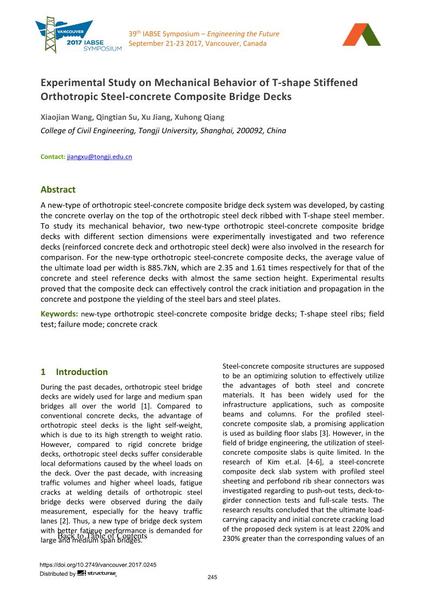Experimental Study on Mechanical Behavior of T-shape Stiffened Orthotropic Steel-concrete Composite Bridge Decks

|
|
|||||||||||
Bibliografische Angaben
| Autor(en): |
Xiaojian Wang
(College of Civil Engineering, Tongji University, Shanghai, 200092, China)
Qingtian Su (College of Civil Engineering, Tongji University, Shanghai, 200092, China) Xu Jiang (College of Civil Engineering, Tongji University, Shanghai, 200092, China) Xuhong Qiang (College of Civil Engineering, Tongji University, Shanghai, 200092, China) |
||||
|---|---|---|---|---|---|
| Medium: | Tagungsbeitrag | ||||
| Sprache(n): | Englisch | ||||
| Tagung: | IABSE Symposium: Engineering the Future, Vancouver, Canada, 21-23 September 2017 | ||||
| Veröffentlicht in: | IABSE Symposium Vancouver 2017 | ||||
|
|||||
| Seite(n): | 245-252 | ||||
| Anzahl der Seiten (im PDF): | 8 | ||||
| Jahr: | 2017 | ||||
| DOI: | 10.2749/vancouver.2017.0245 | ||||
| Abstrakt: |
A new-type of orthotropic steel-concrete composite bridge deck system was developed, by casting the concrete overlay on the top of the orthotropic steel deck ribbed with T-shape steel member. To study its mechanical behavior, two new-type orthotropic steel-concrete composite bridge decks with different section dimensions were experimentally investigated and two reference decks (reinforced concrete deck and orthotropic steel deck) were also involved in the research for comparison. For the new-type orthotropic steel-concrete composite decks, the average value of the ultimate load per width is 885.7kN, which are 2.35 and 1.61 times respectively for that of the concrete and steel reference decks with almost the same section height. Experimental results proved that the composite deck can effectively control the crack initiation and propagation in the concrete and postpone the yielding of the steel bars and steel plates. |
||||
| Stichwörter: |
Versagensart Feldversuch
|
||||
